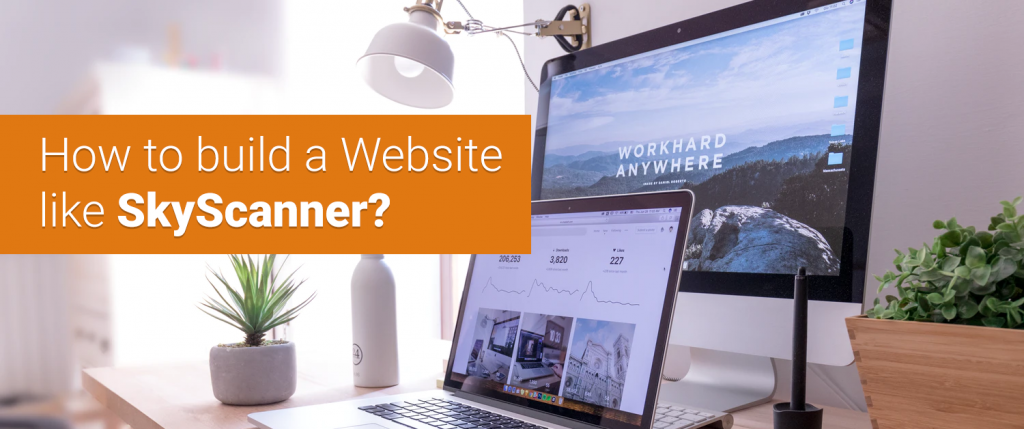
Travel and Tourism is a massive industry that comprises various components: Flight booking, Travel agencies, Insurance companies, Hotel Booking, and much more. It isn’t easy to estimate the importance of websites or applications dealing in this industry. People these days have hundreds of options at their bay. The factors that make an application stand out are quality of service, scalability, and how well it has been marketed.
These factors may dishearten any being who has decided to step into the digital space.
But don’t worry!
Here are some of the surveyed facts that will explain the popularity of these applications, and may even motivate you to step further..
- The number of travel applications downloads was around 2.5 billion in 2009. In 2011, the number went up to 3.1 billion.
- Fast forward ten years (2019), the industry has contributed 2.9 trillion U.S. dollars globally.
In this atmosphere, how exactly is your travel site going to survive? Launching a site against Wego, Skyscanner, Expedia isn’t everyone’s cup of tea. Hence, to survive, the agencies must adapt vitalities and embrace uniqueness to stand out.
Today, in this article, we are going to discuss “How to develop a website like Skyscanner? “But first thing first, let’s get to know this site named Skyscanner.
What is SkyScanner?

Skyscanner is a travel application based in Edinburgh, Scotland. According to the Trip.com group, the app is claimed to be the largest travel company in China. Users can avail Skyscanner for searching and booking hotels, vehicles, flights, for completing their travel.
A travel aggregator site relies heavily on travel agencies like flights and hotel company websites for fetching data to be shown to users. This gives the users an overall picture of rates and availability across various vendors without going from one door to another. A user has to shoot the journey date, and the site would give them the required information.
In simple words, we require –
- CMS, which acts as a framework for the website
- Front-end for maintaining the aesthetics of your site.
- Engine for pulling data from the APIs from data providers.
Alternatively, one can consider developing the site from scratch or use available scripts for the travel portals. Let’s explore what we have in store!
1. Built it from start
Anything built from scratch offers a lot of room for experimentation. One can incorporate whatever features and functionalities they want. Jot a plan and get your development team ready. However, this approach is going to demand a lot of your time and money. If you’re someone whose priority is flexibility, then this is the right approach for you. Leverage Ruby on Rails and Laravel for building your site as it’s going to be huge.
2. Consider using WordPress
WordPress is known for building almost every kind of website. It is because one can easily code a plugin for WordPress for additional functionalities. The site is quite versatile and easy to use for new coders. Tweaking bits and pieces in the WordPress setup will cost a lot less than opting to build the site from scratch. One doesn’t need to be a typical programmer for designing a travel portal on WordPress. Install a travel theme and plugins- you’re on your way!!
-
WordPress Themes
WordPress uses the best performance-enhancing practices for ensuring a seamless user experience. Powered by booking forms, and multiple payment gateways, these themes are even compatible with the famous plugins like WooCommerce.
- Travel Press
- Travel WP
- Pilgrim
- Cruise
-
Plugins
Turn your WordPress site into full-fledged Travel Portal with the help of powerful plugins:
- TourCMS
- Travel Routes
- Travel Agent 1.4
-
Travel Website Scripts
Use dedicated web engines or scripts for building your site as they take care of the critical aspects of the website. These scripts are loaded with powerful features like billing and invoicing, booking engine, customizable options for meeting your requirements:
- PHP Travels
- Bepo Travels
- Wizie
4. Data Collection for the Travel Site
Once the site is ready as a final product, it is time to connect it with data providing systems. Data is the core component, or we can say fuel upon which your site is going to run. Have access to travel agencies, flight, and hotel companies for fetching data, if essential.
There are different ways of data aggregation for the travel website:
-
Affiliate Programs
Almost every leading meta-search engine has affiliate programs in which they provide free APIs access. These APIs can be used for feeding your travel portal, and solve two major issues in one shot- revenue generation and data aggregation. Configure your engine to pull data from the following APIs-
- Expedia Affiliate Program
- Skyscanner Affiliate Program
- Kayak Affiliate Program
-
Web Crawling Services
Not all the sites provide APIs, and these sites may not have the required data fields for a travel organization. This is where web crawling services come into play. The service can turn unstructured data into a structured form, which then can be fed to your database for populating the travel site.
Setting up a web crawler isn’t quite feasible owing to advanced technical obstacles, and hence we recommend using PromptCloud to meet your requirements.
Building a Travel site like Skyscanner or Wego isn’t just done yet, certain elements need emphasis here, especially if you’ve opted for the start from scratch approach:
Must-have Features to be included in a Travel Website

1. Landing Page
The finest strategy of making a site like Skyscanner that targets customers globally is a nation (or language) specific landing page. Greet the users with a search bar present on the first page and direct them to their relevant page.
2. Switch Currencies
If your site deals globally, then it is a must to provide a facility for switching currencies. If your site even provides the hotel booking option, then make sure a region specific filter is applied. The hotels and the acceptable currency must be included on the relevant section.
3. Search & Sort
The site must include all sorts of filters- ratings, cost, popularity for enhancing the users’ experience. Users should be able to sort the destinations or hotels by popularity or costing.
4. Destination Images
Want to lure users? The simple technique is to include images. Integrate images of destination, routes, restaurants, resorts, guest houses, and much more. Provide a gallery that consists of hundreds of attractive images that lure the users enough to get moving and make a booking.
5. Check Deals
If we have to name the essential element of a travel site, then this is the one! Have a “check deals” button on the top and have minimum cost posted there. It must include all the complete packages right from Flight Booking to Hotel Booking, etc. This component’s primary objective is to make visitors tap on this option and take them to the relevant page from where they can make the final booking. Design this option with feasible deals, as this can prove to be the ice-breaker when a user is confused between you and your competitor’s site.
6. Best Destination Spots
Though we have mentioned the review filter above, it is also necessary to include this section; maybe in the footer of your site. List best cities or best destinations for travel based on various segregating elements like :
- Best City for Solo Trip
- Best for Group Traveling
- Popular Destination
- Season-based Cities
- Best for a Family Holiday
- And much more…
This is the spot that is mostly visited by the people hit by Travel Bugs. Don’t forget to give your best shot here.
7. Travel Blogs
Now, here comes the section that we, as a traveller, would explore if ever we go browsing a travelling website. A blog lets the reader step into the traveller’s view and experiences the whole journey from their words. Consequently, the reader may decide to end-up taking the entire trip herself and tap on your deals button. The blog section may even include the leading destinations, or talk about the local market of a famous city, or a new found love story while travelling to your favourite spot, and much more. Just get your team of writers ready and let the world of words move!!
Take-Home Message
In the past few years, travel has been the most profitable niche. Hundreds of thousands of people are inclined to travel, primarily due to easy flight booking, rental cars, online hotel booking facilities, and much more.
Developing a travel site like Skyscanner is not that difficult. It depends upon the complexity of features, scalability of the application, and the luring design. We have taken all the basics into account, and you can kickstart MVP versions of your site. Ready to have a Travel Website in your Brand Name? Feel free to get in touch.
Whether the project is simple or complex, our team of experts will be there with you right from the ideation stage to the final launch.
Like the article? Do tell us in the comment box below!
Happy Traveling!




